The following is a list of radio frequency connector types.
The following is a list of radio frequency connector types.



The following audio and video connectors are sometimes used for RF, but are not generally considered to be RF connectors:

Coaxial cable, or coax, is a type of electrical cable consisting of an inner conductor surrounded by a concentric conducting shield, with the two separated by a dielectric ; many coaxial cables also have a protective outer sheath or jacket. The term coaxial refers to the inner conductor and the outer shield sharing a geometric axis.
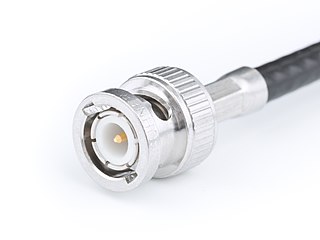
The BNC connector is a miniature quick connect/disconnect radio frequency connector used for coaxial cable. It is designed to maintain the same characteristic impedance of the cable, with 50 ohm and 75 ohm types being made. It is usually applied for video and radio frequency connections up to about 2 GHz and up to 500 volts. The connector has a twist to lock design with two lugs in the female portion of the connector engaging a slot in the shell of the male portion. The type was introduced on military radio equipment in the 1940s and has since become widely applied in radio systems, and is a common type of video connector. Similar radio-frequency connectors differ in dimensions and attachment features, and may allow for higher voltages, higher frequencies, or three-wire connections.

The N connector is a threaded, weatherproof, medium-size RF connector used to join coaxial cables. It was one of the first connectors capable of carrying microwave-frequency signals, and was invented in the 1940s by Paul Neill of Bell Labs, after whom the connector is named.
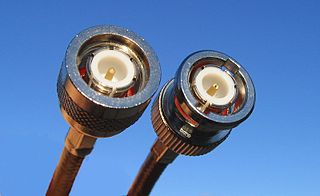
The TNC connector is a threaded version of the BNC connector.

A balun is an electrical device that allows balanced and unbalanced lines to be interfaced without disturbing the impedance arrangement of either line. A balun can take many forms and may include devices that also transform impedances but need not do so. Sometimes, in the case of transformer baluns, they use magnetic coupling but need not do so. Common-mode chokes are also used as baluns and work by eliminating, rather than rejecting, common mode signals.

In electronics, electrical termination is the practice of ending a transmission line with a device that matches the characteristic impedance of the line. Termination prevents signals from reflecting off the end of the transmission line. Reflections at the ends of unterminated transmission lines cause distortion, which can produce ambiguous digital signal levels and misoperation of digital systems. Reflections in analog signal systems cause such effects as video ghosting, or power loss in radio transmitter transmission lines.

The F connector is a coaxial RF connector commonly used for "over the air" terrestrial television, cable television and universally for satellite television and cable modems, usually with RG-6/U cable or with RG-59/U cable.

SMA connectors are semi-precision coaxial RF connectors developed in the 1960s as a minimal connector interface for coaxial cable with a screw-type coupling mechanism. The connector has a 50 Ω impedance. SMA was originally designed for use from DC (0 Hz) to 12 GHz, however this has been extended over time and variants are available to 18 GHz and 26.5 GHz. There are also mechanically compatible connectors such as the K-connector which operate up to 40 GHz. The SMA connector is most commonly used in microwave systems, hand-held radio and mobile telephone antennas and, more recently, with WiFi antenna systems and USB software-defined radio dongles. It is also commonly used in radio astronomy, particularly at higher frequencies (5 GHz+).
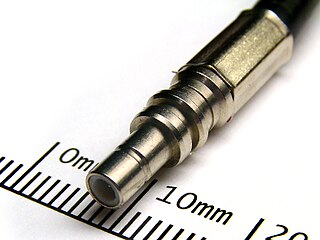
SMB connectors are coaxial RF connectors developed in the 1960s. SMB connectors are smaller than SMA connectors.

SMC connectors are coaxial RF connectors developed in the 1960s. The interface specifications for the SMC and many other connectors are referenced in MIL-STD-348. They use a #10-32 UNF threaded interface. They offer electrical performance from direct current (DC) to 4 GHz. Some extended performance versions are rated to 10 GHz. The normally free part of a SMC connector that has a socket for the centre contact are the female connectors. The normally fixed part SMC connectors that has a pin for the centre contact are the male connectors. This is the reverse of most RF connectors. SMC jack connectors have an external thread while SMC plug connectors have the mating hex nut. The contact dimensions are identical to the snap-fit SMB. Available in 50 ohm and 75 ohm characteristic impedance, they provide an interconnect means for small form factor coaxial cables and printed circuit boards where small footprint is important.

MCX are coaxial RF connectors developed in the 1980s. They have the same inner contact and insulator dimensions as the SMB connector but are 30% smaller. MCX is standardized in European CECC 22220.
RG-58/U is a type of coaxial cable often used for low-power signal and RF connections. The cable has a characteristic impedance of either 50 or 52 Ω. "RG" was originally a unit indicator for bulk RF cable in the U.S. military's Joint Electronics Type Designation System. There are several versions covering the differences in core material and shield.
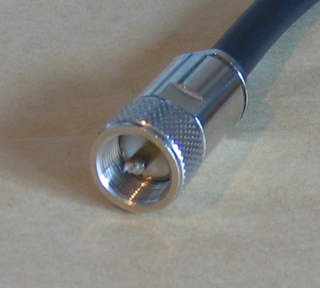
The UHF connector is a name for a threaded RF connector. The connector design was invented in the 1930s for use in the radio industry, and is a shielded form of the "banana plug". It is a widely used standard connector for HF transmission lines on full-sized radio equipment, with BNC connectors predominating for smaller, hand-held equipment.

The Musa connector is a type of coaxial ("coax") connector, originally developed for the manual switching of radio signals. It has a characteristic impedance of 75 Ω, and was adopted for use in the emerging television broadcast industry.

Micro-miniature coaxial (MMCX) connectors are coaxial RF connectors similar to MCX but smaller. They conform to the European CECC 22000 specification. MMCX connectors are rated to 500 mating cycles. The connectors have a lock-snap mechanism allowing 360-degree rotation and usually have a 50 Ω impedance. They offer broadband capability from DC to 6 GHz.
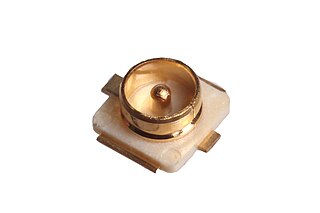
Hirose U.FL, I-PEX MHF I, AMC or UMCC is a miniature RF connector for high-frequency signals up to 6 GHz manufactured by Hirose Electric Group, I-PEX, and others.

A concentric twinax connector has a center pin and a cylindrical intermediate contact as compared to a dual polarized pin type.

The DIN 1.0/2.3 connector is a RF connector used for coaxial cable at microwave frequencies. They were introduced in the 1990s for telecommunication applications. They are available in 50 Ω and 75 Ω impedance and are compatible with the most widely used cable sizes. It has a push/pull lock and release feature. The DIN 1.0/2.3 is ideally suited to applications where space limitation is a factor. In broadcasting applications the 75 Ω version is used for serial digital interface video data up to maximum frequency of 4 GHz. The 50 Ω connector can be used to a maximum of 10 GHz.

The 7-16 DIN connector or 7/16 is a 50 Ω threaded RF connector used to join coaxial cables. It was designed to reduce passive intermodulation from multiple transmitters. It is among the most widely used high power RF connectors in cellular network antenna systems. Originally popular in Europe, it has gained widespread use in the US and elsewhere.

The 4.3-10 connector is a 50 Ω multi-purpose RF connector used to connect coaxial cables with other cables or RF devices, such as transmitters or antennas.